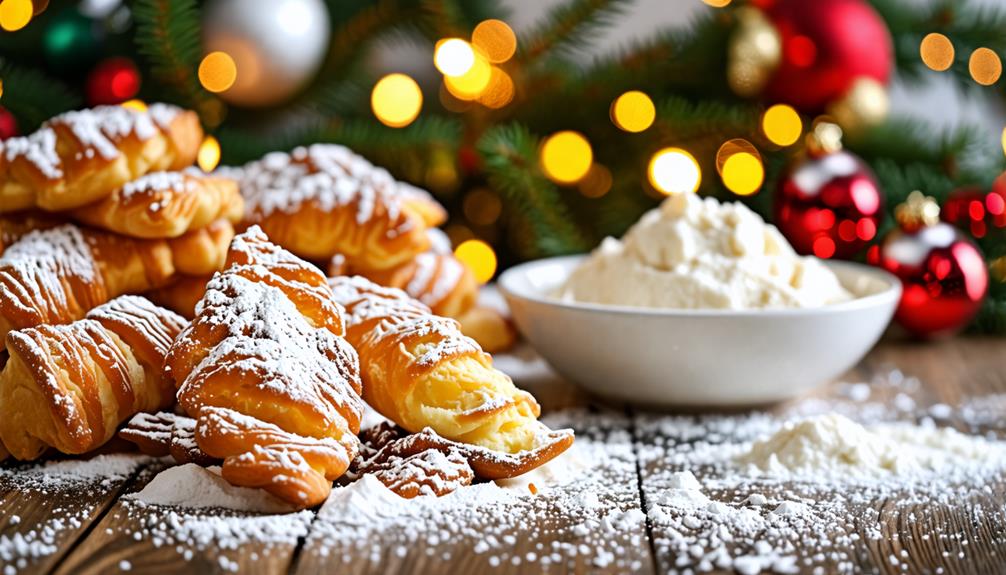In Croatian households, the preparation of fritule during Christmas isn't just a culinary activity; it's a time-honored tradition that bridges generations. These small, sweet treats, often flavored with citrus or spirits, play a significant role in family gatherings, adding a touch of nostalgia to festive celebrations. As families come together to fry these delightful morsels, they create not only delicious memories but also reinforce their cultural identity. Yet, the question remains: what makes fritule an indispensable part of the Croatian Christmas experience? Exploring this further reveals a rich tapestry of flavors and meanings.
Need cookware for your meal? Toolbox, a Pear to Pear rental marketplace, might be worth a look.
Quick Takeaways
- Fritule symbolize family gatherings, enhancing togetherness and creating cherished holiday memories during Christmas celebrations.
- The delightful aroma and flavor of fritule evoke nostalgia, connecting individuals to their cultural heritage.
- Their preparation fosters unity, as families often come together to share the cooking experience, strengthening community ties.
- Fritule showcase regional diversity in Croatian culture, with variations that celebrate local traditions and culinary identities.
- Serving fritule during Christmas adds a festive touch, making them a beloved and integral part of holiday dessert tables.
The Tradition of Fritule
Fritule hold a special place in Croatian Christmas traditions, embodying the joy and warmth of festive celebrations. These delightful, golden fried dough balls aren't just a traditional Christmas treat; they symbolize family gatherings and the spirit of togetherness. Often flavored with zesty citrus and sweet raisins, Croatian fritule captivate the senses, making them a must-have during Christmas Eve festivities.
While they shine during the holiday season, fritule are beloved year-round, enjoyed at various occasions and gatherings. The act of preparing fritule brings families closer, creating a sense of community as they share recipes passed down through generations. Each family might've its own unique twist on this cherished treat, reflecting the regional diversity of Croatian culture.
The nostalgic aroma of frying fritule fills homes, evoking memories of laughter, love, and shared moments. As friends and family gather to savor these sweet delights, they celebrate not only the flavors but also the connections that bind them.
Fritule transcend mere dessert; they represent a culinary heritage that fosters unity, making them an essential part of Croatian holiday traditions.
Key Ingredients for Fritule
A delightful array of key ingredients comes together to create the traditional Croatian fritule, ensuring a perfect blend of flavors and textures. The base of the dough consists of all-purpose flour, yogurt, eggs, and sugar, which work in harmony to create a rich foundation.
Vital to achieving that light and fluffy texture, baking powder plays an important role in the fritule's success.
Optional ingredients like raisins and lemon zest often elevate the flavor profile, adding a touch of sweetness and a revitalizing acidity that tantalizes the taste buds. The incorporation of alcohol, such as Rakija or Rum, not only enhances the overall flavor but also helps reduce oil absorption during frying, resulting in a lighter treat.
Frying the fritule requires vegetable oil, which allows them to achieve that coveted golden-brown exterior. Once they're perfectly cooked, a dusting of powdered sugar finishes the presentation, making them a delightful addition to any festive table.
These carefully selected ingredients come together to create a cherished holiday treat that will surely impress family and friends alike, inviting everyone to gather and enjoy the warmth of the season.
Step-by-Step Preparation
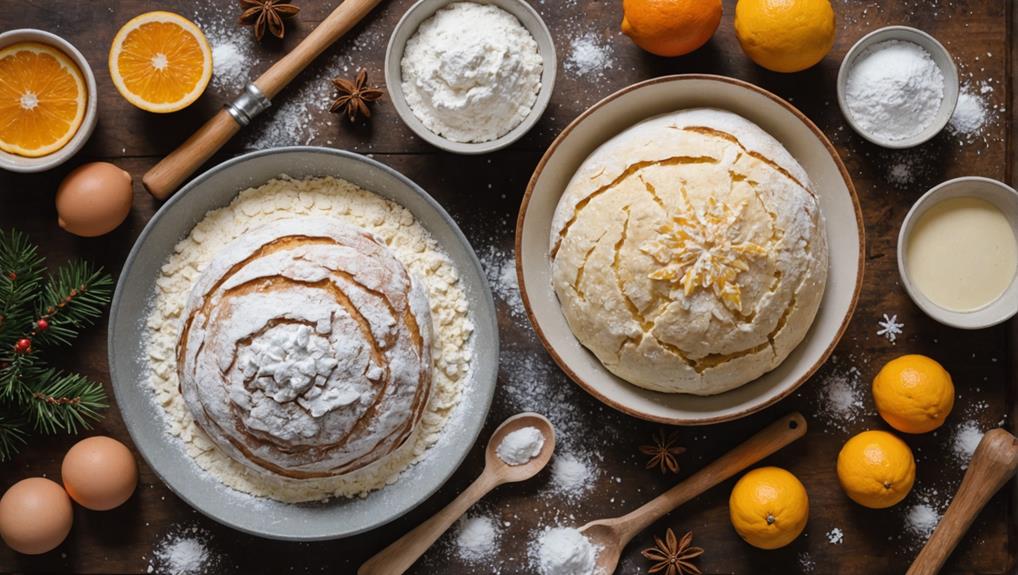
To prepare traditional Croatian fritule, one must first gather essential ingredients, ensuring the perfect blend of dry and wet components.
Once the batter is ready, mastering the frying technique becomes vital for achieving that delightful golden brown finish.
With careful attention to temperature and timing, anyone can enjoy these festive treats freshly made and dusted with powdered sugar.
Essential Ingredients Overview
In preparing traditional Croatian fritule, the selection of essential ingredients plays a fundamental role in achieving that delightful balance of flavor and texture. The base of the fritule consists of all-purpose flour, plain yogurt, eggs, granulated sugar, and baking powder, which combine to form a soft, pliable dough.
To elevate the flavor profile, many bakers incorporate a splash of alcohol, like Croatian Rakija or brandy, which not only enhances taste but also minimizes oil absorption during frying.
For those looking to add an extra layer of complexity, optional ingredients such as raisins and citrus zest can be included. These additions not only provide distinct textures but also a revitalizing burst of flavor.
Here's a quick overview of the essential ingredients:
- All-purpose flour: The foundation of the dough.
- Vegetable oil: Critical for achieving that golden, crispy exterior.
- Citrus zest: Adds a vibrant and aromatic touch.
Allowing the dough to rest for 15 to 30 minutes before frying guarantees a consistent texture, making it easier to serve these delightful treats to loved ones.
Frying Techniques Explained
Frying fritule is where the magic truly happens, transforming the simple dough into golden, fluffy delights that fill the kitchen with irresistible aromas.
To commence this culinary adventure, one must begin by mixing the dry ingredients, such as flour and baking powder, in one bowl. In another, combine wet ingredients like yogurt, sugar, and eggs before merging them to create a smooth batter. Allow the fritule dough to rest for 15 to 30 minutes, enhancing its consistency for better frying results.
Next, heat the oil in a frying pan to a consistent temperature of around 350 degrees Fahrenheit. This precise heat guarantees the fritule cook evenly, achieving that desirable golden brown exterior.
Using two dessert spoons, shape and drop small amounts of batter into the hot oil, frying in small batches to prevent overcrowding, which can disrupt the oil temperature.
Once the fritule turn a beautiful golden yellow, remove them from the oil and let them drain on kitchen paper to absorb excess oil.
The Role of Alcohol
In the preparation of fritule, alcohol plays a crucial role in enhancing the flavor profile and creating a delightful aroma.
Spirits like Rakija or Rum not only contribute to the sweet and festive taste but also help reduce fat absorption during frying, resulting in lighter, less greasy treats.
This traditional addition aligns beautifully with Croatian culinary customs, showcasing regional preferences while maintaining the beloved characteristics of these bite-sized delights.
Flavor Enhancement Through Spirits
The rich aroma of traditional Croatian fritule wafts through homes during the holiday season, a delightful treat that embodies the spirit of celebration. One of the key secrets to their irresistible flavor lies in the incorporation of spirits, such as Rakija or rum, into the dough. This addition not only provides a distinct boozy note that beautifully complements the sweetness but also enhances the overall experience of the fritule.
With each bite, you'll discover a unique fusion of flavors, making these treats highly addictive.
Here's how spirits elevate this festive delight:
- Flavor Depth: Alcohol infuses the dough with complex flavors that dance on the palate.
- Lighter Texture: The spirits help reduce fat absorption during frying, yielding a lighter, less greasy fritule.
- Cultural Connection: Using traditional Croatian spirits connects the dish to its rich cultural heritage.
As families gather to enjoy these festive treats, the role of alcohol serves as a celebration of indulgence and joy, ensuring that every fritula isn't just a dessert but a cherished memory.
Oil Absorption Reduction Techniques
Incorporating alcohol into the fritule batter serves a dual purpose, enhancing both flavor and texture while minimizing oil absorption during frying. Spirits like Croatian Rakija or Rum not only elevate the taste but also play a vital role in achieving that perfect fritule.
When heated, alcohol evaporates at a lower temperature than water, creating steam that effectively pushes moisture out of the dough. This process results in a lighter, less greasy fritule that everyone will enjoy.
The use of alcohol contributes to a delightful crunch on the outside while keeping the inside soft and tender. This balance makes fritule more appetizing, especially when served during festive occasions.
Additionally, the alcohol content aids in achieving a lovely golden brown color, as it interacts with the sugars and proteins in the batter during frying.
Traditional recipes often suggest using about 45ml of alcohol per batch, a perfect amount to harness the benefits of oil absorption reduction techniques without overwhelming the dish's original flavor.
This approach guarantees that the fritule aren't only delicious but also light and inviting, making them a cherished treat for family and friends during the holiday season.
Cultural Significance
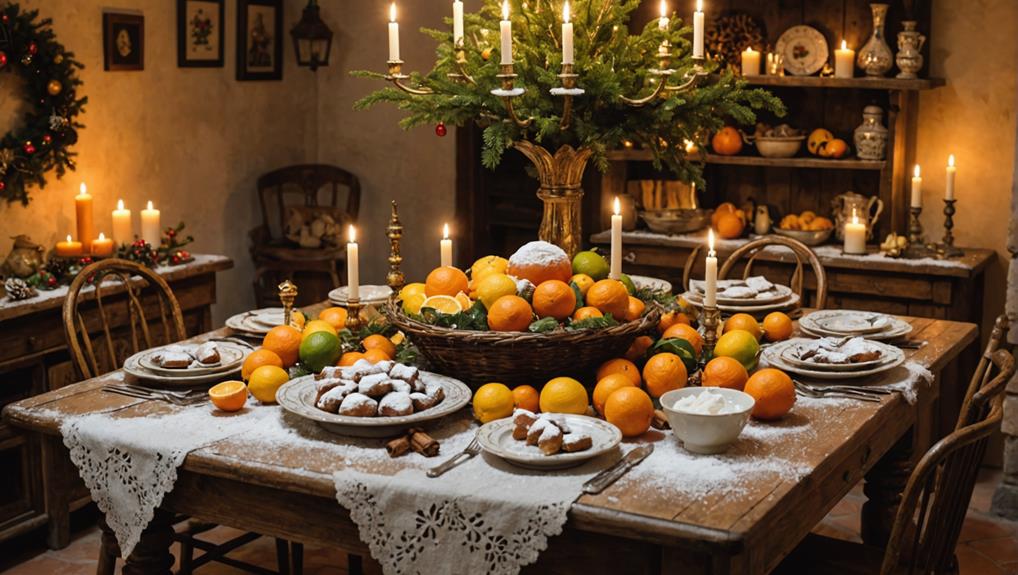
What makes fritule an enduring symbol of Christmas in Croatian culture? These delightful doughnuts represent more than just a tasty treat; they embody the spirit of celebration and togetherness that defines the festive season. Often served on Christmas Eve, fritule evoke nostalgia, reminding families of their shared heritage and the bonds that unite them.
Their cultural significance can be highlighted through a few key aspects:
- Celebration of Tradition: Fritule are a cherished part of holiday traditions, passed down through generations.
- Community Connections: The preparation and sharing of these treats strengthen ties among family and friends, reinforcing cultural identity.
- Regional Variations: Different fritule recipes across Croatia showcase the diversity of the culinary landscape, allowing families to add their personal touches.
Beyond Christmas, fritule also grace tables during other festive occasions, like Carnival and Lent, further embedding their role in Croatian cultural celebrations.
As families gather to create and enjoy these sweet morsels, they weave a tapestry of memories that enrich their holiday experiences and strengthen their community bonds.
Serving Suggestions
Warmly served fritule instantly elevate any Christmas gathering, enchanting guests with their delightful aroma and inviting appearance. For a classic festive presentation, dusting these golden-brown treats with powdered sugar is a must. This simple touch enhances their visual appeal and adds a touch of sweetness that everyone loves.
To complement the flavors of fritule, serve them with a glass of Croatian Rakija or a steaming mug of mulled wine. These beverages not only enhance the tasting experience but also contribute to the warm, holiday atmosphere.
For those looking to indulge further, a light drizzle of honey or rich chocolate sauce can transform fritule into an even more decadent delight.
Presenting fritule in bite-sized portions encourages sharing, fostering a communal dining experience that strengthens bonds among family and friends.
Additionally, consider pairing fritule with other traditional Croatian desserts to create a diverse and festive dessert table. This not only showcases cultural heritage but also provides guests with an array of flavors to enjoy.
With these serving suggestions, fritule will certainly be the highlight of any Christmas celebration.
Variations Across Regions
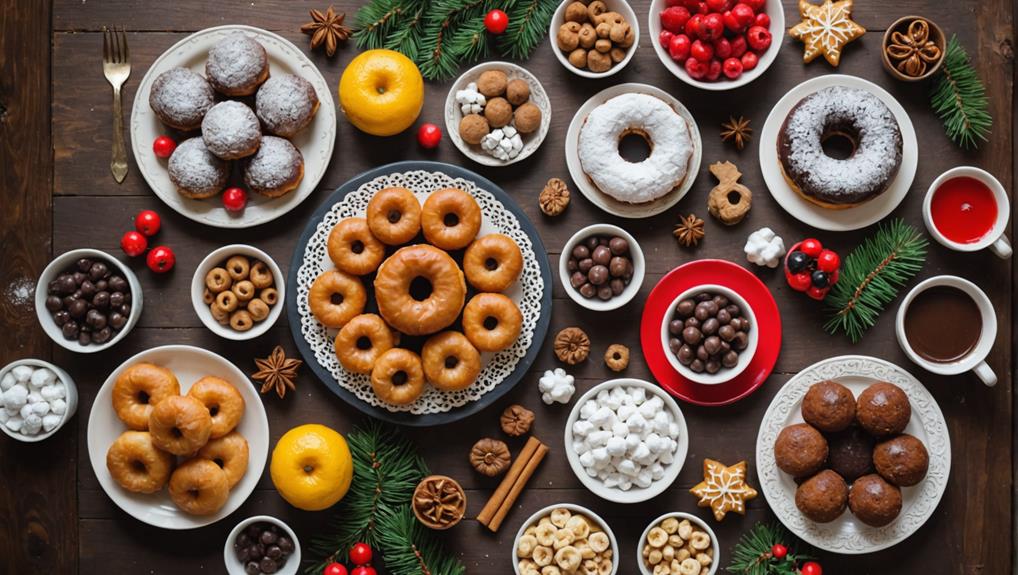
Fritule, a beloved Croatian treat, showcases a delightful diversity that reflects the rich tapestry of regional traditions. Each region adds its own twist to this festive delicacy, making them unique and special during the Christmas season.
In Dalmatia, for instance, fritule often feature citrus zest and raisins, enhancing the flavor profile with a burst of freshness. Other regions might introduce different fruits or nuts, such as apples and walnuts, creating a plethora of tastes to enjoy.
Here are a few notable variations across regions:
- Alcohol Choices: Some areas prefer rakija, while others might select rum or brandy.
- Dough Texture: Recipes vary, with some using yeast for a lighter dough and others opting for baking powder.
- Flavor Enhancements: Unique spices, like vanilla or chocolate, may be incorporated, showcasing local influences.
The shape and size of fritule also differ, with bite-sized versions being popular in some regions and larger dough balls favored in others.
This regional diversity not only brings joy to the table but also preserves culinary traditions, making each batch of fritule a celebration of Croatia's rich heritage.
Tips for Perfect Fritule
To achieve the perfect fritule, attention to detail is key. Start by preparing the dough; using a combination of yogurt and eggs enhances both the moistness and flavor of the dough balls.
Once mixed, let the dough rest for 15 to 30 minutes. This resting period is essential for developing a lighter texture and richer taste.
Next, heat the oil to around 350 degrees Fahrenheit. Maintaining this temperature is critical to guarantee the fritule cook evenly without becoming greasy or burnt.
Fry the dough balls in small batches, as overcrowding can lower the oil temperature, leading to soggy fritule.
As the fritule fry to a golden perfection, keep an eye on them. Once they're ready, dust the warm fritule with powdered sugar immediately after removing them from the oil.
This step not only enhances their presentation but also adds a delightful sweetness that complements their flavor.
With these tips in hand, anyone can create a batch of traditional Croatian fritule that will impress family and friends alike during the festive season.
Fritule in Modern Celebrations
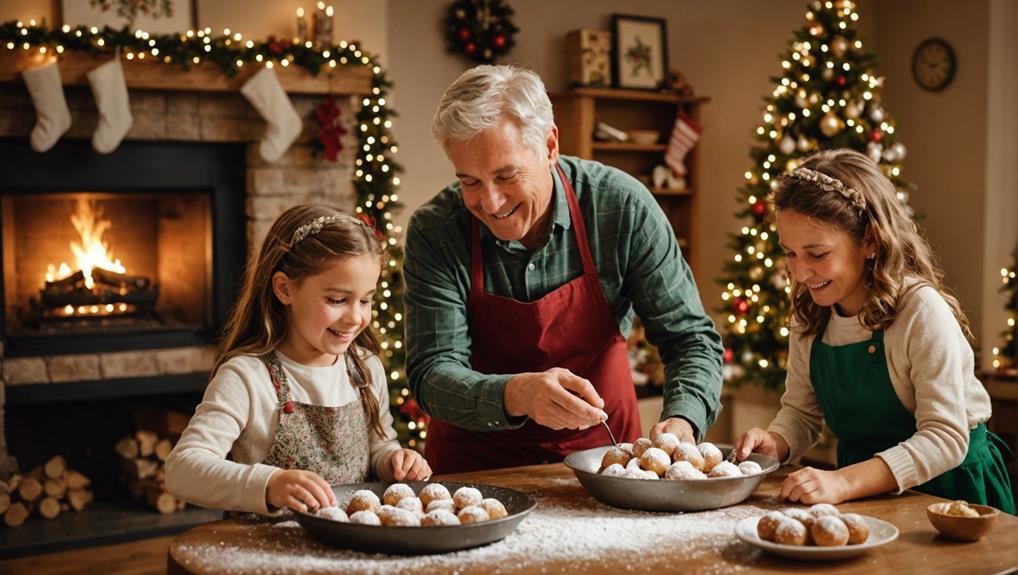
During the festive season, fritule continue to hold a cherished place in Croatian celebrations, evolving gracefully with modern tastes while retaining their traditional roots. Families gather to prepare these delightful mini doughnuts, a bonding activity that brings generations together.
Traditionally flavored with citrus zest and raisins, fritule evoke the warmth of holiday spirit.
In today's kitchens, fritule in modern celebrations showcase a delightful twist, often incorporating contemporary ingredients. Home bakers are experimenting with variations that can include:
- Rich chocolate pieces for a decadent touch
- Flavored liqueurs, adding a festive kick
- Nutty additions like almonds or hazelnuts for texture
Despite these innovations, the essence of fritule remains intact. They're still served alongside an array of holiday desserts, reinforcing their role as a staple on Croatian Christmas tables.
This adaptability demonstrates how fritule can bridge the gap between tradition and modernity, allowing everyone to enjoy their festive flair. Whether enjoyed plain or with a twist, fritule invite both nostalgia and excitement, making them a beloved component of holiday gatherings, and a sweet reminder of cherished family traditions.
Common Questions
What Is the History of the Fritule?
The fritule's history intertwines with ancient Roman cuisine, evolving through centuries to reflect local Croatian flavors. Originating in Dalmatia, these festive treats symbolize community, indulgence, and cultural heritage during celebrations like Christmas and Carnival.
What Is Croatia's Christmas Dish?
Croatia's Christmas dish, fritule, delights families with its sweet, citrus-infused dough. These golden, fluffy treats, often dusted with powdered sugar, evoke warmth and joy, making them a cherished addition to festive gatherings.
What Is a Croatian Fruitle?
A Croatian fritule are delightful, golden fried dough balls, often flavored with citrus zest and raisins. Crispy outside and fluffy inside, they're perfect for sharing, bringing joy to gatherings with their irresistible taste and festive spirit.
What Are Some Croatian Christmas Traditions?
In Croatia, families gather to celebrate Advent, lighting candles and sharing meals. They enjoy traditional caroling and prepare festive dishes, fostering warmth and connection, while sweet fritule often grace the table, symbolizing joy and community.
Wrapping Up
At its core, making traditional Croatian fritule for Christmas is more than just a culinary activity; it's a heartfelt tradition that strengthens family bonds and evokes cherished memories. With approximately 80% of Croatian households preparing these sweet treats during the festive season, fritule truly embody the spirit of togetherness. As families gather around the frying pan, the warm aroma fills the air, reminding everyone of their rich cultural heritage and the joy of shared celebrations.
